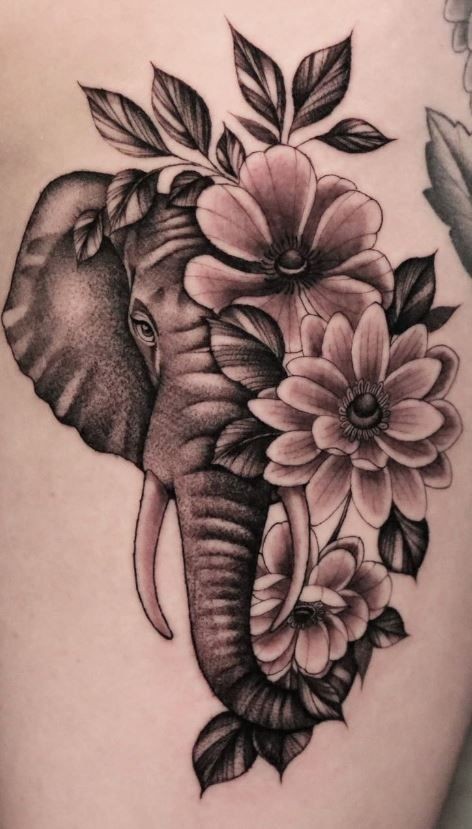100 Elephant Tattoos: A Comprehensive Guide
Elephant tattoos have gained popularity for their deep symbolism and striking aesthetics. These majestic animals are often associated with wisdom, strength, and tranquility. Whether you're considering your first tattoo or looking to add to your collection, elephant tattoos offer a range of styles and meanings that can resonate with different individuals. Here’s an extensive guide to 100 elephant tattoos, exploring their symbolism, design variations, and cultural significance.
1. Symbolism of Elephant Tattoos
Elephants are revered across various cultures, often symbolizing:
Wisdom and Knowledge: Elephants are known for their intelligence and memory. They represent a deep connection to wisdom.
Strength and Power: Their sheer size and physical power make them a symbol of strength and resilience.
Loyalty and Family: Elephants have strong family bonds and are seen as symbols of loyalty and protection.
Good Luck: In some cultures, an elephant with its trunk up is considered a symbol of good fortune and prosperity.
Tranquility and Peace: The gentle nature of elephants can symbolize peace and calm.
2. Design Variations
Traditional Elephant Tattoos
Traditional designs often feature bold lines and vibrant colors. These tattoos usually depict elephants in their natural form, with detailed textures and realistic proportions.
Minimalist Elephant Tattoos
Minimalist designs focus on simplicity and clean lines. These tattoos often use basic shapes and minimal detail to capture the essence of an elephant.
Geometric Elephant Tattoos
Geometric tattoos incorporate shapes and patterns to create a stylized representation of an elephant. These designs often use symmetry and abstraction to form a modern look.
Watercolor Elephant Tattoos
Watercolor tattoos use vibrant, flowing colors to mimic the look of watercolor paintings. These tattoos often appear fluid and dynamic, capturing the graceful nature of elephants.
Tribal Elephant Tattoos
Tribal designs feature intricate patterns and shapes that draw inspiration from various indigenous cultures. These tattoos often use black lines and shading to create a bold, graphic effect.
Mandala Elephant Tattoos
Mandala tattoos combine the intricate patterns of mandalas with the form of an elephant. These designs often emphasize symmetry and spiritual significance.
Realistic Elephant Tattoos
Realistic tattoos aim to capture the lifelike appearance of elephants. These designs require detailed shading and skillful rendering to create a true-to-life depiction.
Abstract Elephant Tattoos
Abstract tattoos use unconventional shapes and forms to represent an elephant. These designs often prioritize artistic expression over realistic portrayal.
Small Elephant Tattoos
Small tattoos are perfect for subtle placements like the wrist or ankle. They can be designed in various styles, from minimalist to detailed.
Large Elephant Tattoos
Large tattoos often cover more significant areas of the body, such as the back or thigh. These designs can incorporate detailed artwork and multiple elements.
3. Cultural and Mythological Significance
Hinduism
In Hindu culture, the elephant-headed god Ganesha is worshipped as the remover of obstacles and the god of beginnings. Elephant tattoos inspired by Ganesha often incorporate elements like a lotus flower or a raised trunk.
Buddhism
Elephants in Buddhism represent mental strength and the path to enlightenment. In Buddhist art, elephants are often shown as symbols of protection and purity.
African Culture
In many African cultures, elephants are revered for their power and are often depicted in art and symbolism. Tattoos inspired by African art might incorporate tribal patterns and motifs.
Thai Culture
In Thailand, elephants are considered sacred and are integral to various ceremonies and festivals. Thai elephant tattoos might feature traditional Thai art styles and motifs.
4. Placement Ideas
Arm: Elephants can be designed to wrap around the arm or positioned on the upper arm or forearm.
Back: A large canvas, the back is ideal for detailed and intricate elephant tattoos.
Leg: The thigh or calf can accommodate larger designs or wrap-around tattoos.
Wrist: Small and minimalist designs work well on the wrist or forearm.
Side: The side of the torso provides ample space for large, detailed tattoos.
5. Choosing the Right Elephant Tattoo
When selecting an elephant tattoo, consider the following:
Personal Meaning: Choose a design that resonates with your personal values or experiences.
Design Style: Select a style that aligns with your aesthetic preferences.
Tattoo Artist: Find a skilled tattoo artist who specializes in the style you want.
Placement: Consider how the tattoo’s size and design will fit with the placement on your body.
6. Caring for Your Elephant Tattoo
Proper care ensures your tattoo heals well and looks great for years to come:
Follow Aftercare Instructions: Adhere to your tattoo artist’s aftercare recommendations.
Keep It Clean: Wash the tattoo with mild soap and water.
Moisturize: Apply a tattoo-specific moisturizer to keep the skin hydrated.
Avoid Sun Exposure: Protect your tattoo from direct sunlight to prevent fading.
Conclusion
Elephant tattoos are a powerful and versatile choice, representing a range of meanings from wisdom to strength. Whether you prefer a traditional design or a modern twist, the variety of styles ensures that there’s an elephant tattoo for everyone. Take your time to choose a design that reflects your personal significance and fits your aesthetic, and your elephant tattoo will be a meaningful addition to your body art.






